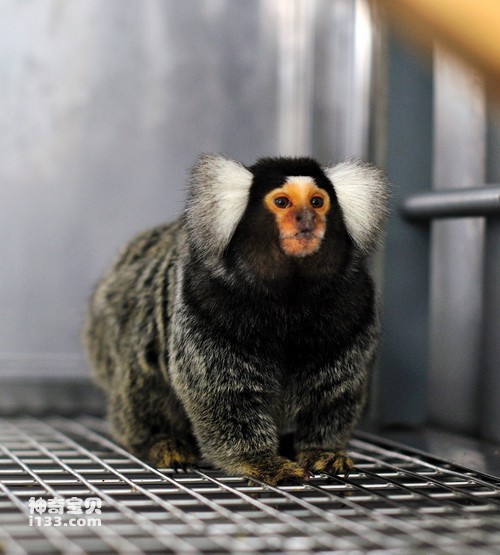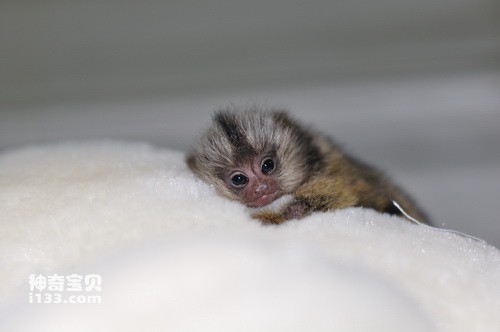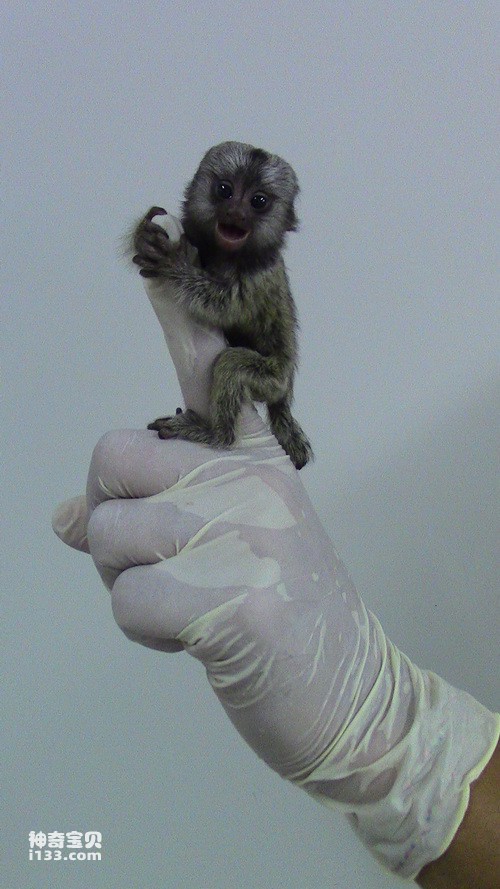If you have watched the movie "Rio", you will definitely have an impression of the army of monkey thieves in it: the monkey uses the stolen gold watch as a belt to pretend to be rich. This scene graphically illustrates the size of the marmoset. The homeland of marmosets is the forests of northeastern Brazil. Due to human breeding and other reasons, they have also been introduced to cities in southeastern Brazil, including Rio de Janeiro, and have become local invasive species. Therefore, they are described in movies as thieves who do bad things.

The most eye-catching appearance of this group of little monkeys is that there is a tuft of cotton-like white hair on each ear, so they are called cotton-eared marmoset. In terms of biological classification, there are dozens of species of marmosets, among which the cotton-eared marmoset is the most common, also known as the common marmoset. Even when they reach adulthood, their body length is only 20 centimeters at most and their weight is 300 to 400 grams, which is less than the weight of a bottle of ordinary mineral water. Newborn marmosets have not yet grown their iconic white ear hairs. They are about the same length as an adult's fingers and weigh only about 30 grams. It is certainly not a problem to hold a person's fingers and play in the palm of their hands.
The Elf in the Forest
In order to adapt to life in the tropical rainforest, marmosets have evolved a set of weapons: strong hind limbs ensure strong jumping ability, claw-like nails that allow them to firmly cling to branches, and a tail that is almost as long as the body for control. Balance of the trunk during jumping. Marmosets are omnivores just like us humans. Flowers, fruits, gums, and insects in the forest are their favorite foods. Sometimes they also steal bird eggs and prey on small vertebrates and reptiles.

The marmoset has a pair of enviable double-lidded eyes. Scientists have discovered that marmosets have very sharp eyesight and, like humans, rely on two eyes at the same time to accurately judge the distance of objects, allowing them to jump and fly in the jungle and come and go freely. However, marmosets are not as good at color recognition as we are, and all male marmosets are red-green blind. Interestingly, only some of the female marmosets are red-green blind, while others have normal color vision like us.
The calls of marmosets are very rich and similar to those of birds. They are also the king of high-pitched sounds, and some of the frequencies of their calls are even beyond the range of recognition by human ears. Of course, their hearing has also evolved remarkably well. In the forest, marmosets are small but have a large range of activities. Coupled with the cover of leaves, vocal communication is almost the most important way of communication between marmosets.
The marmoset's sense of smell is also very sensitive. Not only can it use its sense of smell to find food and determine whether the food is ripe, but it can also provide early warning of potential intruders and natural enemies. What's more, marmosets also use scent to mark and communicate, such as using urine to demarcate their own territory or leaving identifying scent messages for other marmosets.
Love each other as a small family
Marmoset families are also very similar to our human families. In the wild, a marmoset family has 3 to 15 members, including a marmoset father, a marmoset mother, and their two children. At about one and a half years old, marmosets can leave their parents and start their own family.
Marmoset family members have a clear division of labor. Dad is an absolute model worker, shouldering the important task of defending his homeland against foreign enemies, and at the same time, he is also responsible for going out to find food. The mother is responsible for birthing and nursing, but the main responsibility for raising the baby is still the responsibility of the marmoset father. The older brothers and sisters of the marmoset baby will also participate in taking care of the baby, especially the eldest son in the family. On the one hand, they can help the parents share the work, and on the other hand, they can also gain experience for themselves when they go out to start a new family in the future. Newborn marmoset babies will lie tightly on the backs of their parents or older siblings. In the 3rd to 5th week after birth, the baby's motor skills begin to develop, and the baby can walk alone. In the 8th week after birth, The motor skills of baby marmosets are basically mature.

A good helper for scientific research
Both marmosets and macaques are primates like humans, so they have long been used in human biomedical research, especially in brain science-related research. In China, because there are more macaques, most laboratories currently choose to use macaques as research subjects. Compared with macaques, marmosets have the advantages of small size, fast reproduction, and small breeding space. Moreover, marmosets are more similar to humans in some aspects. For example, the family structure of marmosets is closer to humans and can be used to study human social behavior; marmosets have richer vocal communication and are more suitable for studying human language than macaques.
In 2009, Japanese scientists developed a genetically modified marmoset. The cells of these transgenic marmosets have an extra green fluorescent protein, so they turn green when illuminated by a specific fluorescent light. Even more remarkable is that the baby marmosets they gave birth to also had this green fluorescent protein. This is the first time that scientists have obtained a transgenic monkey that can be successfully passed down the generations! Currently, laboratories around the world are still trying to breed more transgenic marmosets, which will provide important help for us to understand the mysteries of the human brain.
Now, marmoset monkeys have also arrived in Chinese laboratories. Soon, these elves will surely help Chinese scientists make important scientific discoveries.
animal tags: Primates monkeys marmosets macaques
We created this article in conjunction with AI technology, then made sure it was fact-checked and edited by a Animals Top editor.